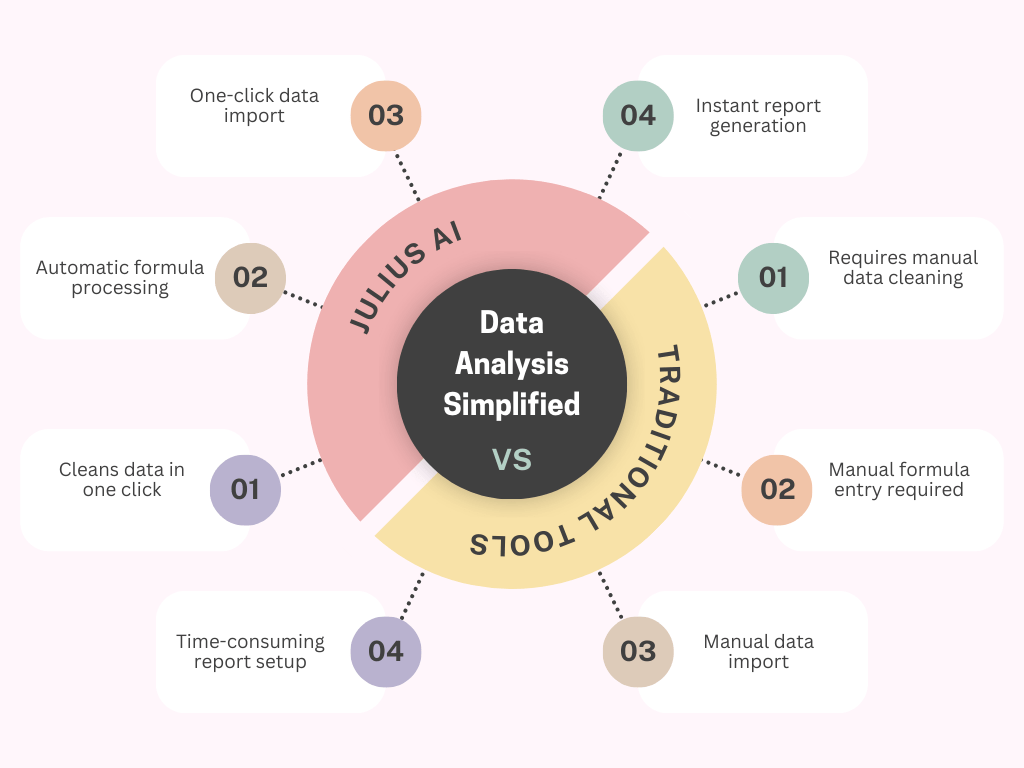
In today’s fast-paced digital world, businesses rely heavily on data to make informed decisions. Yet, analyzing data with traditional tools often involves time-consuming, error-prone processes. This is where Julius AI emerges as a game-changer, offering a simplified, efficient, and automated solution to data analysis. In this blog, we’ll explore how Julius AI compares to traditional tools and why it’s the future of data analysis.
Data analysis has come a long way. Traditional tools like spreadsheets and manual processes once served as the backbone of business analytics. While they were revolutionary in their time, these methods are now riddled with inefficiencies such as slow processing, frequent errors, and high reliance on human effort. The advent of AI-powered tools like Julius AI is transforming this landscape, enabling businesses to streamline data analysis with unprecedented ease and speed.
3.1 Cleaning Data
Traditional Tools: Cleaning data manually is labor-intensive and prone to errors, requiring users to sift through large datasets to remove inconsistencies.
Julius AI: With just one click, Julius AI cleans datasets, ensuring accuracy and saving hours of manual work.
3.2 Formula Processing
Traditional Tools: Manual formula entry often leads to mistakes, especially in complex calculations.
Julius AI: Automates formula processing, handling calculations efficiently and accurately, even for advanced analytics.
3.3 Data Import
Traditional Tools: Importing data often requires manual input, which is both time-consuming and prone to formatting errors.
Julius AI: Supports one-click data import, seamlessly integrating multiple data formats for faster processing.
3.4 Report Generation
Traditional Tools: Generating reports manually requires significant time, especially for proper formatting and insights.
Julius AI: Instantly generates professional reports, offering actionable insights with minimal effort.
6.1 Business Analytics
Track key performance indicators (KPIs) efficiently, ensuring timely business decisions.
6.2 Finance
Eliminate errors in financial calculations and enhance forecasting accuracy.
6.3 Marketing
Analyze customer behavior, campaign performance, and market trends effortlessly.
6.4 Education
Organize and analyze research data, supporting academia with robust insights.
Today’s businesses require scalability and precision that traditional tools cannot provide. Julius AI addresses these needs, enabling companies to align with modern practices, remain competitive, and improve decision-making efficiency. Transitioning to Julius AI enhances productivity while freeing up resources for strategic initiatives.
9.1 Company A
Reduced report generation time by 50%, enabling faster decision-making.
9.2 Company B
Improved data accuracy, leading to better strategic planning and revenue growth.
9.3 Company C
Enhanced team collaboration through cloud-based analytics and shared insights.
As AI technology continues to evolve, Julius AI remains at the forefront, integrating machine learning advancements to improve data analysis capabilities. With its scalable and adaptive features, Julius AI is poised to transform industries and redefine data-driven decision-making.
Julius AI simplifies data analysis, addressing the inefficiencies of traditional tools with automated, user-friendly solutions. From one-click data cleaning to instant report generation, Julius AI empowers businesses to harness the full potential of their data, paving the way for a smarter, more efficient future. Embrace Julius AI today to transform the way you analyze and utilize data.

Dr. Chopra is the founder and editor of thephdcoaches.blogs and Thephdcoaches Learn more about her here and connect with her on Instagram, Facebook and LinkedIn.
Dr. Tripti Chopra, founder of The PhD Coach, is an award-winning mentor and leader in integrating AI into academic research, with over a decade of experience guiding PhD students and researchers. Her work revolutionizes research processes, promotes sustainable writing practices, and inspires scholars to embrace technological advancements.
Copyright© 2023 Thephdcoach All rights reserved.
Leave a Comment